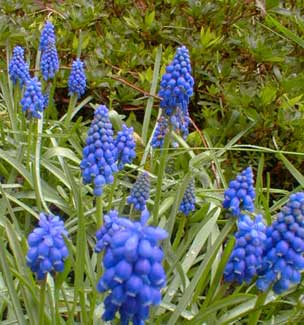
Armenian Grape Hyacinth
"Poetry is the synthesis of hyacinths & biscuits."
-Carl Sandberg,
1878-1967
1878-1967
Wild Muscari armeniacum grape hyacinths have been gardened in Europe since 1871, which makes it a come-lately compared to M. ambrosiacum gardened since 1554, & M. neglectum gardened since 1868.
A few plain wild Armenian grape hyacinth bulbs were planted out on the roadside beside the telephone pole, not far from a patch of nearly identical M. botryoides. Both have the classic blue cone or pyramid of little florets, but M. armeniacum adds a little rim of white around the edge of each "grape."
Both species produce new foliage in autumn after their summer dormancy, but the grass of M. botryoides is long & floppy, whereas for M. armeniacum it is stiff & spidery. So only the spring flowers look nearly the same; the leaves are nowhere near the same.
Although the similarity of these two species may make it seem a bit silly to have them both, M. botryoides starts blooming sooner (in March), & M. armeniacum is still around when the early muscaris are finished by mid-April. So there are grape hyacinths somewhere in the garden for an extra extended period of time.
In a friend's garden where I've done some landscaping, I planted about a hundred bulbs under the Sequoia tree. This large grouping is in shade, & our own small drift in the Garden of Paghat the Ratgirl is in full sun, & both do fabulously. They all happen to be in fairly droughty locations, but the bulbs would be just as adaptable to well irrigated locations.
One problem with the bigger drift I planted is it's a property visited by deer, & turns out they just love the Armenian wild hyacinth. So one day it was a beautiful group of blooms, & the next day all the blue blossoms were eaten!
These are popular bulbs for indoor forcing in winter, or for containers, as well as just about anywhere in the open garden. I put some in a container one autumn just for the heck of it, & they put on quite a show the following spring; they just can't fail.
Suited to zones 4-8 (stretchable for 3-9), this native of southern Europe & the Caucusas Mountains naturalizes & spreads both by producing bulb offsets, & by self-seeding. Unlike a lot of bulbs that are said to naturalize easily but which vanish after a few years, this one's no problem at all: you plant 'em, you've got 'em forever.
There are quite a lot of cultivars & we have a few of these in addition to the unnamed or wild strain. We've planted 'Cote d'Azur' & 'Dark Eyes' but these really don't stand out as particularly different from the wild grape hyacinth, though 'Valerie Finnis' is a unique powder-blue which doesn't seed but is repoduces its bulbs by offsets with considerable abandon.